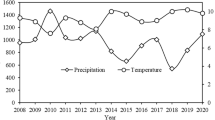Abstract
Changes in deposition exert effects on forests. Some evidence for a slow recovery of strongly alkalised forest soils after a reduction in alkaline pollution exists, but the recovery rate is little known. The objective of this study was to estimate temporal soil reaction changes. For this purpose, measurements of soil reaction under a beech forest near magnesite works in Central Slovakia were taken in 1991 and 2006, following the alkaline pollution reduction in 1992. As a result, the mean active soil reaction decreased from pH 7.8 to 6.6. Beyond the range of beech stemflow, which amplifies water and acid pollution inputs into soils locally, soil reaction dropped from pH 7.8 to 6.8. The effect of stemflow on local exchangeable reaction minima was detected even before the pollution reduction. The logarithmic function fitted on the pH data indicates considerable differences between neutralisation rates within and outside the stemflow zone.








Similar content being viewed by others
References
Bellmann, K., & Grote, R. (1998). Introduction to the SANA-project. In R. F. Hüttl & K. Bellmann (Eds.), Changes of atmospheric chemistry and effects on forest ecosystems: A roof experiment without a roof, nutrients in ecosystems, 3 (pp. 1–15). Dordrecht: Kluwer.
Bobro, M., Hančuľák, J., Dorčáková, H., & Bálintová, M. (2000). Monitoring of emission load in soils in the Muránska valley. Acta Montanistica Slovaca, 5, 33–35.
Bringmark, E. (1989). Spatial variation in soil pH of beech forests in relation to buffering properties and soil depths. Oikos, 54, 165–177. doi:10.2307/3565262.
Bublinec, E. (1971). Intoxication of soil adjacent to a magnesite plant, its melioration and impact on plants nutrition. Biologické práce (Bratislava), 27, 1–88.
Chang, S.-C., & Matzner, E. (2000). The effect of beech stemflow on spatial patterns of soil solution chemistry and seepage fluxes in a mixed beech/oak stand. Hydrological Processes, 14, 135–144. doi:10.1002/(SICI)1099-1085(200001)14:1<135::AID-HYP915>3.0.CO;2-R.
Evers, F. H. (1983). Orientierende Untersuchungen langfristiger Bodenreaktionsänderungem in südwestdeutschen Düngungs-versuchsflächen. Der Forst-und Holzwirt, 38, 317–320.
Falkengren-Grerup, U., & Tyler, G. (1993). The importance of soil acidity, moisture, exchangeable cation pools and organic matter solubility to the cationic composition of beech forest (Fagus sylvatica L.) soil solution. Zeitschrift Pflanzenernährung Bodenkunde, 156, 365–370. doi:10.1002/jpln.19931560414.
Gersper, P. L., & Holowaychuk, N. (1970). Effect of stemflow water on a Miami soil under a beech tree. Morphological and physical properties. Soil Science Society of America Proceedings, 34, 779–786.
Gömöryová, E. (2004). Small-scale variation of microbial activities in a forest soil under a beech (Fagus sylvatica L.) stand. Polish Journal of Ecology, 52, 311–321.
Haapala, H., Goltsova, N., Pitulko, V., & Lodenius, M. (1996). The effects of simultaneous large acidic and basic pollution on forest soil. Environmental Pollution, 94, 159–168. doi:10.1016/S0269-7491(96)00072-3.
Hančuľák, J., & Bobro, M. (2004). Impact of magnesite industry on the solid emission load in the Jelšava area. Acta Montanistica Slovaca, 9, 401–405.
Hronec, O. (1996). Air pollution, soil, vegetation. Bratislava: SPK.
Jochheim, H., & Schäfer, H. (1988). “Die Baumfuss—Methode” dargestellt anhand einer Untersuchung der Immissionsbelastung von Nordwest–Jugoslawischen Buchenwälder. Zeitschrift für Pflanzenernähr. Bodenk, 151, 81–85. doi:10.1002/jpln.19881510203.
Johnson, S., & Lehmann, J. (2006). Stemflow and root-induced preferential flow: The double-funneling of trees. Ecoscience, 13, 324–333. doi:10.2980/i1195-6860-13-3-324.1.
Kara, O., & Bolat, I. (2007). Impact of alkaline dust pollution on soil microbial biomass carbon. Turkish Journal Of Agriculture and Forestry, 31, 181–188.
Kauppi, P., Kämäri, J., Posch, M., Kauppi, L., & Matzner, E. (1986). Acidification of forest soils: Model development and application for analyzing impacts of acidic deposition in Europe. Ecological Modelling, 33, 231–253. doi:10.1016/0304-3800(86)90042-6.
Kautz, G., Zimmer, M., Zach, P., Kulfan, J., & Topp, W. (2001). Suppression of soil microorganisms by emissions of a magnesite plant in the Slovak Republic. Water, Air, and Soil Pollution, 125, 121–132. doi:10.1023/A:1005272000832.
Kazda, M., & Glatzel, G. (1984). Schwermetallanreichungem und Schwermetallverfügbarkeit im Einsickerungsbereich von Stammablaufwasser in Buchenwäldern (Fagus sylvatica L.) des Wienerwaldes. Zeitschrift fuer Pflanzenernähr. Bodenk, 147, 743–752. doi:10.1002/jpln.19841470612.
Kida, Y., Mita, Y., Fukushi, K., & Sato, T. (2005). Mechanisms of alkaline buffering by peat and quantitative estimation of its buffering capacity. Landscape and Ecological Engineering, 1, 127–134.
Klose, S., & Makeschin, F. (2003). Effects of past fly ash deposition on the forest floor humus chemistry of pine stands in Northeastern Germany. Forest Ecology and Management, 183, 113–126. doi:10.1016/S0378-1127(03)00099-9.
Kľúčiarová, D., Márton, P., Pichler, V., & Túnyi, I. (2008). Pollution detection by the susceptibility measurements aided by stemflow effect. Water, Air, and Soil Pollution, 189, 213–223. doi:10.1007/s11270-007-9569-8.
Levia, D. F. (2003). Winter stemflow nutrient inputs into a southern New England broadleaved deciduous forest. Geografiska Annaler, 85 A, 13–20.
Liblik, V., Pensa, M., & Rätsep, A. (2003). Air pollution zones and harmful pollution levels of alkaline dust for plants. Water Air and Soil Pollution Focus, 3, 193–203. doi:10.1023/A:1026061330172.
Machin, J., & Navas, A. (2000). Soil pH changes induced by contamination by magnesium oxides dust. Land Degradation & Development, 11, 37–50. doi:10.1002/(SICI)1099-145X(200001/02)11:1<37::AID-LDR366>3.0.CO;2-8.
Mandre, M. (2002). Relationships between lignin and nutrients in Picea abies L. under alkaline air pollution. Water, Air, and Soil Pollution, 133, 363–379. doi:10.1023/A:1012987503033.
Matzner, E., Khanna, P. K., Meiwes, K. J., Lindheim, M., Prenzel, J., & Ulrich, B. (1982). Elementflüsse in Waldökosystemen im Solling—Datendokumentation. Göttinger Bodenkundliche Berichte, 71, 1–267.
Papritz, A. (1993). Estimating temporal change of soil properties. Doctoral thesis, Swiss Federal Institute of Technology, Zürich, pp. 166.
Papritz, A., & Webster, R. (2005). Estimating temporal change in soil monitoring: II. Sampling from simulated fields. European Journal of Soil Science, 46, 13–27. doi:10.1111/j.1365-2389.1995.tb01809.x.
Pichler, V., Bublinec, E., & Gregor, J. (2006). Acidification of forest soils in Slovakia—Causes and consequences. Journal of Forest Science, 52, 23–27.
Riebeling, R., & Schäfer, C. (1984). Jahres-und Langzeitentwicklung der pH-Werte von Waldböden in hessischen Fichtenbeständen. Forst und Holzwirt, 39, 177–182.
Schaaf, W., Wecker1, T. P., & Hüttl, R. F. (2003). Changes in top soil properties of forest soils in north-eastern Germany due to long-term element accumulation. Plant and Soil, 264, 85–95. doi:10.1023/B:PLSO.0000047713.27594.70.
Schnider, F., Attinger, W., & Flühler, H. (1989). Die räumliche Variabilität des pH im Oberboden und die Nachweisbarkeit von zeitlichen pH-Änderungen. Schweizerische Zeitschrift fuer Forstwesen, 140, 475–481.
Sokal, R. R., & Rohlf, F. J. (1995). Biometry. New York: Freeman.
Sparks, D. L. (2003). Environmental soil chemistry. London: Academic.
Staelens, J., De Schrijver, A., Verheyen, K., & Verhoest, N. E. C. (2008). Rainfall partitioning into throughfall, stemflow, and interception within a single beech (Fagus sylvatica L.) canopy: influence of foliation, rain event characteristics, and meteorology. Hydrological Processes, 22, 33–45. doi:10.1002/hyp.6610.
Tervahattu, H., Lodenius, M., & Tulisalo, E. (2001). Effects of the reduction of cement plant pollution on the foliar and bark chemical composition on Scots pine. Boreal Environment Research, 6, 251–259.
Thadewald, T., & Buning, H. (2007). Jarque–Bera test and its competitors for testing normality—A power comparison. Journal of Applied Statistics, 34, 87–105. doi:10.1080/02664760600994539.
Tuulmets, L. (1995). Air pollution and growth conditions of forest trees. Chemical composition of precipitation. In M. Mandre (Eds.), Dust pollution and forest ecosystems. A study of conifers in an alkalized environment (pp. 23–32). Tallin: Institute of Ecology.
Ulrich, B. (1983). Soil acidity and its relations to acid deposition. In B. Ulrich, & P. Pankrath (Eds.), Effects of accumulation of air pollutants in forest ecosystems (pp. 127–143). Dordrecht: Reidel.
van Breemen, N., Mulder, J., & Driscoll, C. T. (1983). Acidification and alkalization of soils. Plant and Soil, 75, 283–308. doi:10.1007/BF02369968.
Werner, W. (1988). Stickstoff-u. Phosphor—Mineralisation im Versickerungsbereich des Stammablaufwassers von Buchen. Flora, 181, 339–352.
Závodský, D. (2002a). Sulphur deposition from domestic and foreign sources. The landscape atlas of the Slovak Republic. Bratislava: Ministry of Environment.
Závodský, D. (2002b). Nitrogen deposition from domestic and foreign sources. The landscape atlas of the Slovak Republic. Bratislava: Ministry of Environment.
Acknowledgements
This investigation was supported by scientific grants awarded by the Research and Development Agency APVV-0468-06 and the Scientific Grants Agency of the Ministry of Education and the Slovak Academy of Sciences No. 1/0703/08 and MVTS COST FP0601.
Author information
Authors and Affiliations
Corresponding author
Rights and permissions
About this article
Cite this article
Pichler, V., Homolák, M. & Capuliak, J. Long-Term Soil Reaction Changes in a Temperate Beech Forest Subject to Past Alkaline Pollution. Water Air Soil Pollut 204, 5–18 (2009). https://doi.org/10.1007/s11270-009-0021-0
Received:
Accepted:
Published:
Issue Date:
DOI: https://doi.org/10.1007/s11270-009-0021-0




